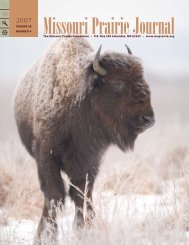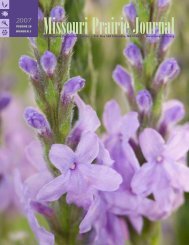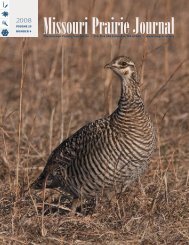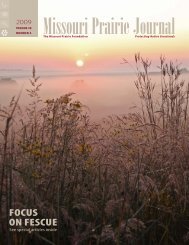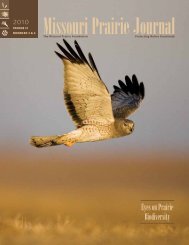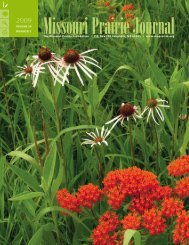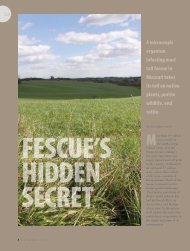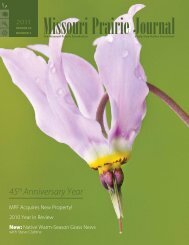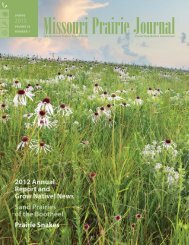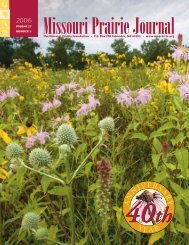Fall & Winter 2012: Volume 33, Numbers 3 & 4 - Missouri Prairie ...
Fall & Winter 2012: Volume 33, Numbers 3 & 4 - Missouri Prairie ...
Fall & Winter 2012: Volume 33, Numbers 3 & 4 - Missouri Prairie ...
You also want an ePaper? Increase the reach of your titles
YUMPU automatically turns print PDFs into web optimized ePapers that Google loves.
Fate of 67 nests of radio-collared hens monitored from 2009 to <strong>2012</strong>.<br />
Area<br />
# 2009<br />
Nests<br />
# 2009<br />
Successful<br />
# 2010<br />
Nests<br />
# 2010<br />
Successful<br />
# 2011<br />
Nests<br />
# 2011<br />
Successful<br />
# <strong>2012</strong><br />
Nests<br />
Wah’Kon-Tah 4 3 6 5 22 15 11 9<br />
Taberville 4 2 4 3 8 5 6 6<br />
Walker 0 0 0 0 1 1 0 0<br />
Shelton 0 0 0 0 0 0 1 1<br />
Totals 8 5 10 8 31 21 18 16<br />
# <strong>2012</strong><br />
Successful<br />
Telemetry Monitoring Observations:<br />
Tracking radio-marked females and the<br />
fate of their nests and broods has added<br />
to our understanding of the vegetative<br />
cover that greater-prairie chickens prefer<br />
for nesting, raising broods, feeding, and<br />
evading predators. Although additional<br />
monitoring is needed for statistical confirmation,<br />
observations to date indicate<br />
the importance of maintaining a patchwork<br />
of varying herbaceous vegetation<br />
types across large, unfragmented grasslands<br />
of at least several hundred acres.<br />
Prescribed fire, patch-burn grazing, and<br />
high-clipping relatively small, 40- to<br />
80-acre units within larger grassland<br />
landscapes all appear important to create<br />
and maintain this variety of herbaceous<br />
cover heights and densities. Additional<br />
telemetry monitoring observations<br />
include:<br />
• Given comparatively poor survival<br />
among translocated juveniles, spring<br />
translocation is recommended over the<br />
two-phase approach, which included<br />
summer recapture of previously radiomarked<br />
females and their broods.<br />
• Translocation efforts proved successful<br />
in terms of lek establishment, site fidelity,<br />
and production at Wah’Kon-Tah<br />
and interaction with native birds at<br />
Taberville <strong>Prairie</strong> (Jamison and Alleger<br />
2009).<br />
• Dispersal rates are higher and survival<br />
is lower among first-year translocated<br />
birds compared to resident birds<br />
(Kemink <strong>2012</strong>).<br />
• The acclimation period over which<br />
translocated birds experience depressed<br />
survival is approximately six months<br />
(Kemink <strong>2012</strong>).<br />
• Increasing winter flock numbers at<br />
Taberville <strong>Prairie</strong> indicate an increase<br />
in bird recruitment from local subpopulations.<br />
It is not known whether<br />
this is a direct result of translocation.<br />
• <strong>Winter</strong> trapping documented successful<br />
brood-rearing at Wah’Kon-Tah, as<br />
juvenile birds lacking transmitters and<br />
leg bands have been observed and/or<br />
trapped.<br />
• With regard to the Partners in Flight<br />
Grassland Bird habitat model (PIF<br />
Model), birds prefer Departmentmanaged<br />
“core” habitat, and survival<br />
is lower on smaller, privately owned,<br />
“satellite” tracts (Kemink <strong>2012</strong>).<br />
• The presence of fences and trees<br />
reduces the amount of usable space<br />
(Kemink <strong>2012</strong>).<br />
• Future translocation efforts should<br />
consider releasing larger numbers of<br />
birds, biased toward females (Kemink<br />
<strong>2012</strong>).<br />
MDC staff will continue monitoring<br />
this re-established population at<br />
Wah’Kon-Tah to evaluate the long-term<br />
effectiveness of translocation as a greater<br />
prairie-chicken recovery tool. <strong>Winter</strong><br />
trapping will continue at Wah’Kon-Tah<br />
and Taberville prairies over the next<br />
four years to further document individual<br />
survival, nest site selection and<br />
success, and brood survival, with special<br />
emphasis on understanding habitat<br />
While habitat preference data are still being<br />
analyzed, it appears that management<br />
treatments such as patch-burn grazing and<br />
high-clipping, shown above, which reduces<br />
the height and density of vegetation, influence<br />
prairie-chicken nest site selection.<br />
selection patterns. This documentation<br />
will inform future management methods<br />
and priorities. Lek counts will help<br />
determine post-translocation population<br />
stability.<br />
Thinking Forward<br />
This translocation project has succeeded<br />
in reestablishing a functional greater<br />
prairie-chicken population at Wah’Kon-<br />
Tah. The long-term stability of that<br />
population hinges on the continuation<br />
of intensive grassland management on<br />
MDC-managed lands, as well as upon<br />
further efforts to reduce fragmentation<br />
and add viable nesting and brood-rearing<br />
cover on nearby private lands.<br />
Each time I’ve returned home<br />
from greater prairie-chicken trapping<br />
I’ve been struck by the daunting difference<br />
in scale between our grasslands<br />
and those in Kansas’ Smoky Hills. Do<br />
we have enough unfragmented prairie<br />
Steve CLubine<br />
Vol. <strong>33</strong> Nos. 3 & 4 <strong>Missouri</strong> <strong>Prairie</strong> Journal 15




